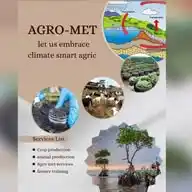
Agro-met services, information and advisory
February 25, 2025 at 02:51 PM
What Is Intercropping in Agriculture?
Intercropping is a farming system that involves growing multiple crop species together within the same season, in contrast to monoculture farming. This method varies in plant arrangement, sowing time, and crop combinations. Perennials can be intercropped with other perennials or annuals, and annuals can be combined with other annuals. For instance, garlic and tomatoes form a perennial-annual intercropping match, while coffee and bananas are a common perennial combination in tropical regions.
Depending on the sowing time, intercropped plants may be planted simultaneously or when one crop has already reached flowering or harvesting stages.
Types of Intercropping
1. Row Cropping
In this system, crops are arranged in distinct rows to optimize space and resource utilization. A common example is corn and beans, where legumes help fix nitrogen in the soil. Farmers may plant crops in single or multiple -row ratios, such as four rows of maize followed by six rows of soybeans.
2. Strip Intercropping
Similar to row cropping, strip intercropping involves planting different crops in wide strips that allow for mechanical farming and independent cultivation. For instance, a common strip cropping pattern in the U.S. includes alternating rows of wheat, corn, and soybeans.
3. Alley Cropping
This technique involves growing crops in between trees, hedges, or bushes, forming alley-like spaces. The taller plants protect the smaller ones from strong winds, excessive sunlight, and soil erosion. This method is especially useful in agroforestry systems.
4. Relay Cropping
In relay cropping, a second crop is planted on the same land after the first crop has flowered. This method ensures a continuous harvest while reducing competition for resources. Examples include cotton and corn or chickpea and upland rice. The second crop must be shade-tolerant to thrive under the canopy of the first crop.
5. Temporal Intercropping
This system involves planting crops with different maturation periods. A fast-growing crop is harvested early, allowing the slower-growing one to continue developing with more space and fewer resource constraints.
6. Mixed Intercropping
In mixed intercropping, different crops are sown together without a specific arrangement. Both sowing and harvesting occur simultaneously. This method provides natural protection against harsh weather conditions such as winds, droughts, and frosts.
7. Trap Cropping
This technique uses pest-attracting crops to divert insects and diseases away from the main crop. Popular trap plants include mustard and marigold, which help protect cash crops by luring pests to themselves. A well-known example is the Blue Hubbard squash, which effectively attracts and traps squash bugs, vine borers, and cucumber beetles.
8. Guard Cropping
Guard crops act as natural barriers by surrounding cash crops or field edges. These plants are either thorny or hardy, providing protection against strong winds and pest invasions. Sorghum around cotton and safflower around chickpeas are common examples.
9. Repellant Intercropping
This method involves planting species that repel pests naturally. Farmers use certain crops as a sustainable pest-management strategy. For instance, leeks are planted alongside beans to deter bean flies, reducing the need for chemical pesticides.
10. Push-Pull Cropping
A combination of trap and repellant cropping, this system strategically places trap plants to attract (pull) pests and repellant plants to push them away from the main crop. A well-known example is planting Napier grass (which pulls pests) and Desmodium legume (which pushes pests away) to protect corn from stem-boring larvae.
Conclusion
Intercropping is a sustainable and resource-efficient farming method that enhances soil health, biodiversity, and pest control while increasing crop yields. By selecting the right intercropping strategy, farmers can optimize land use, reduce dependency on chemical inputs, and build a resilient agricultural system.
SELL YOUR FARM PRODUCE ON www.myshambaexpress.com FOR FREE!
#intercropping #sustainablefarming #organicfarming #pestcontrol #agricul